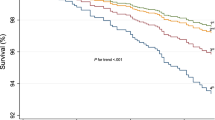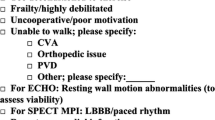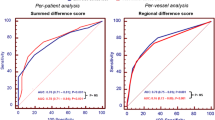Abstract
Stress myocardial perfusion imaging (MPI) plays an important role in the diagnostic and prognostic assessment of coronary artery disease (CAD) in patients of all age groups who are undergoing assessment prior to non-cardiac surgery. MPI may utilise exercise treadmill or pharmacological stress testing. While MPI has been evaluated in a wide variety of patient subpopulations, there are very limited data on its prognostic value in the elderly population, particularly those >75 years of age, who are making up an ever increasing proportion of the patient population. Because of the higher prevalence and greater severity of CAD in older patients, the sensitivity of noninvasive MPI increases with age, whereas specificity tends to decline. In addition, maximal aerobic exercise capacity tends to decrease with age, making it common practice for elderly patients being assessed for CAD to undergo pharmacological MPI to evaluate their cardiovascular risk. In this article, we review the literature with respect to cardiac risk estimation in elderly patients undergoing MPI, particularly with respect to making prognostic assessments prior to undergoing surgery. Current data allow for the proper application of stress MPI in the elderly population. Use of MPI facilitates identification of the severity and extent of ischaemia as well as left ventricular dilatation and systolic function in elderly patients undergoing non-cardiac surgery.




Similar content being viewed by others
References
Jeger RV, Zellweger MJ, Kaiser C, et al. Prognostic value of stress testing in patients over 75 years of age with chronic angina. Chest 2004; 125: 1124–31
Eagle KA, Berger PB, Calkins H, et al. ACC/AHA guideline update for perioperative cardiovascular evaluation for noncardiac surgery: executive summary. A report of the American College of Cardiology/American Heart Association Task Force on Practice Guidelines (Committee to Update the 1996 Guidelines on Perioperative Cardiovascular Evaluation for Noncardiac Surgery). Circulation 2002 Mar 12; 105(10): 1257–67
Ritchie JL, Bateman TM, Bonow RO, et al. Guidelines for clinical use of cardiac radionuclide imaging: report of the American College of Cardiology/American Heart Association Task Force on Assessment of Diagnostic and Therapeutic Cardiovascular Procedures (Committee on Radionuclide Imaging), developed in collaboration with the American Society of Nuclear Cardiology. J Am Coll Cardiol 1995; 25: 521–47
Statistics on the aging population. Department of Health and Human Services Administration on Aging [online]. Available from URL: http://www.aoa.gov/prof/Statistics/statistics.asp [Accessed 2006 Dec 12]
DePuey EG, Rozanski A. Using gated technetium-99m-sestamibi SPECT to characterize fixed myocardial defects as infarct or artifact. J Nucl Med 1995; 36: 952–5
De Winter O, Van de Veire N, Gemmel F, et al. Myocardial perfusion imaging in the elderly: a review. Nucl Med Commun 2006 Jun; 27(6): 529–34
Travain MI, Wexler JP. Pharmacological stress testing. Semin Nucl Med 1999 Oct; 29(4): 298–318
Germano G, Kiat H, Kavanagh PB, et al. Automatic quantification of ejection fraction from gated myocardial perfusion SPECT. J Nucl Med 1995; 36: 2138–47
Shah PK, Pichler M, Berman DS, et al. Left ventricular ejection fraction determined by radionuclide ventriculography in early stages of first transmural myocardial infarction: relation to short-term prognosis. Am J Cardiol 1980; 45: 542–6
Faber TL, Cooke CD, Folks RD, et al. Left ventricular function and perfusion from gated SPECT perfusion images: an integrated method. J Nucl Med 1999; 40: 650–9
Lerner DJ, Kannel WB. Patterns of coronary heart disease morbidity and mortality in the sexes: a 26-year follow-up of the Framingham population. Am Heart J 1986; 111: 383–90
Kannel WB, Feinleib M. Natural history of angina pectoris in the Framingham study: prognosis and survival. Am J Cardiol 1972; 29: 154–63
Aronow WS, Fleg JL. Diagnosis of coronary artery disease in the elderly. In: Aronow WS, Fleg JL, editors. Cardiovascular disease in the elderly. 3rd ed. New York: Marcel Dekker, Inc., 2004: 251–71
Fleg JL, Kennedy HL. Long-term prognostic significance of ambulatory electrocardiographic findings in apparently healthy subjects >60 years of age. Am J Cardiol 1992; 70: 748–51
Tresch DD, Alla HR. Diagnosis and management of myocardial ischemia (angina) in the elderly patient. Am J Geriatr Cardiol 2001; 10: 337–44
Aronow WS. Silent MI: prevalence and prognosis in older patients diagnosed by routine electrocardiograms. Geriatrics 2003; 58: 24–40
Mark DB, Shaw L, Harrell Jr FE, et al. Prognostic value of a treadmill exercise score in outpatients with suspected coronary artery disease. N Engl J Med 1991; 325: 849–53
Kwok JM, Miller TD, Hodge DO, et al. Prognostic value of the Duke treadmill score in the elderly. J Am Coll Cardiol 2002; 39: 1475–81
Iskandrian AS, Heo J, Kong B, et al. Effect of exercise level on the ability of thallium-201 tomographic imaging in detecting coronary artery disease: analysis of 461 patients. J Am Coll Cardiol 1989; 14: 1477–86
Geleijnse ML, Elhendy A, Fioretti PM, et al. Dobutamine stress myocardial perfusion imaging. J Am Coll Cardiol 2000 Dec; 36(7): 2017–27
Taillefer R. Radionuclide myocardial perfusion imaging protocols. In: Heller GV, Hendel RC, editors. Nuclear cardiology: practical applications. New York: McGraw-Hill Medical Publishing Division, 2004: 135–43
DePuey EG, editor. Imaging guidelines for nuclear cardiology procedures. American Society of Nuclear Cardiology [online]. Available from URL: http://www.asnc.org/imageuploads/Imaging%20Guidelines%20Stress%20Protocols.pdf [Accessed 2006 Aug 28]
Lam JY, Chaitman BR, Glaenzer M, et al. Safety and diagnostic accuracy of dipyridamole-thallium imaging in the elderly. J Am Coll Cardiol 1988; 11: 585–9
Wang FP, Amanullah AM, Kiat H, et al. Diagnostic efficacy of stress technetium 99m-labeled sestamibi myocardial perfusion single-photon emission computed tomography in detection of coronary artery disease among patients over age 80. J Nucl Cardiol 1995; 2: 380–8
Deluca AJ, Cusack E, Aronow WS, et al. Sensitivity, specificity, positive predictive value, and negative predictive value of the dipyridamole sestamibi stress test in predicting graft occlusion or > or = 50% new native coronary artery disease in men versus women and in patients aged > or = 65 years versus <65 years who had prior coronary artery bypass grafting. Am J Cardiol 2004 Sep 1; 94(5): 625–6
Steingart RM, Hodnett P, Musso J, et al. Exercise myocardial perfusion imaging in elderly patients. J Nucl Cardiol 2002 Nov–Dec; 9(6): 573–80
Curtis JP, Ko DT, Wang Y, et al. The prognostic value of vasodilator myocardial perfusion imaging in octogenarians. Am J Geriatr Cardiol 2004 Sep–Oct; 13(5): 239–45
Zafrir N, Mats I, Solodky A, et al. Prognostic value of stress myocardial perfusion imaging in octogenarian population. J Nucl Cardiol 2005 Nov–Dec; 12(6): 671–5
De Winter O, Velghe A, Van de Veire N, et al. Incremental prognostic value of combined perfusion and function assessment during myocardial gated SPECT in patients aged 75 years or older. J Nucl Cardiol 2005 Nov–Dec; 12(6): 662–70
Zafrir N, Mats I, Solodky A, et al. Characteristics and outcome of octogenarian population referred for myocardial perfusion imaging: comparison to non-octogenarian population with reference to gender. Clin Cardiol 2006 Mar; 29(3): 117–20
Goraya TY, Jacobsen SJ, Pellikka PA, et al. Prognostic value of treadmill exercise testing in elderly persons. Ann Intern Med 2000 Jun 6; 132(11): 862–70
Iskandrian AS, Heo J, Decoskey D, et al. Use of exercise thallium-201 imaging for risk stratification of elderly patients with coronary artery disease. Am J Cardiol 1988 Feb 1; 61(4): 269–72
Abidov A, Hachamovitch R, Hayes SW, et al. Prognostic impact of hemodynamic response to adenosine in patients older than age 55 years undergoing vasodilator stress myocardial perfusion study. Circulation 2003 Jun 17; 107(23): 2894–9
Shaw L, Chaitman BR, Hilton TC, et al. Prognostic value of dipyridamole thallium-201 imaging in elderly patients. J Am Coll Cardiol 1992 Jun; 19(7): 1390–8
Hilton TC, Shaw LJ, Chaitman BR, et al. Prognostic significance of exercise thallium-201 testing in patients aged greater than or equal to 70 years with known or suspected coronary artery disease. Am J Cardiol 1992 Jan 1; 69(1): 45–50
Hachamovitch R, Berman DS, Kiat H, et al. Incremental prognostic value of adenosine stress myocardial perfusion single-photon emission computed tomography and impact on subsequent management in patients with or suspected of having myocardial ischemia. Am J Cardiol 1997; 80(4): 426–33
Hachamovitch R, Berman DS, Kiat H, et al. Exercise myocardial perfusion SPECT in patients without known coronary artery disease: incremental prognostic value and use in risk stratification. Circulation 1996; 93(5): 905–14
Hachamovitch R, Hayes SW, Friedman J, et al. Comparison of the short-term survival benefit associated with revascularization compared with medical therapy in patients with no prior coronary artery disease undergoing stress myocardial perfusion single photon emission computed tomography. Circulation 2003; 107(23): 2900–7
Morrow K, Morris CK, Froelicher VF, et al. Prediction of cardiovascular death in men undergoing noninvasive evaluation for coronary artery disease. Ann Intern Med 1993; 118: 689–95
Makaryus AN, Veneziano M, Kohn N, et al. The prognostic value of nuclear stress testing in elderly patients undergoing moderate to high-risk surgery [abstract]. J Am Coll Cardiol 2006 Feb; 47 (4 Suppl. A): 107A–8A
Leppo JA, Dahlberg ST. The question: to test or not to test in preoperative cardiac risk evaluation. J Nucl Cardiol 1998; 5: 332–42
Eagle KA, Rihal CS, Mickel MC, et al. Cardiac risk of noncardiac surgery: influence of coronary disease and type of surgery in 3368 operations. CASS Investigators and University of Michigan Heart Care Program. Coronary Artery Surgery Study. Circulation 1997; 96: 1882–7
Guidelines and indications for coronary artery bypass graft surgery: a report of the American College of Cardiology/American Heart Association Task Force on Assessment of Diagnostic and Therapeutic Cardiovascular Procedures (Subcommittee on Coronary Artery Bypass Graft Surgery). J Am Coll Cardiol 1991; 17: 543–89
Elmore JR, Hallett Jr JW, Gibbons RJ, et al. Myocardial revascularization before abdominal aortic aneurysmorrhaphy: effect of coronary angioplasty. Mayo Clin Proc 1993; 68: 637–41
Allen JR, Helling TS, Hartzler GO. Operative procedures not involving the heart after percutaneous transluminal coronary angioplasty. Surg Gynecol Obstet 1991; 173: 285–8
Gottlieb A, Banoub M, Sprung J, et al. Perioperative cardiovascular morbidity in patients with coronary artery disease undergoing vascular surgery after percutaneous transluminal coronary angioplasty. J Cardiothorac Vasc Anesth 1998; 12: 501–6
Smith Jr SC, Dove JT, Jacobs AK, et al. ACC/AHA guidelines of percutaneous coronary interventions (revision of the 1993 PTCA guidelines): executive summary. A report of the American College of Cardiology/American Heart Association Task Force on Practice Guidelines (Committee to Revise the 1993 Guidelines for Percutaneous Transluminal Coronary Angioplasty). J Am Coll Cardiol 2001; 37: 2215–38
McFalls EO, Ward HB, Moritz TE, et al. Coronary-artery revascularization before elective major vascular surgery. N Engl J Med 2004 Dec 30; 351(27): 2795–804
Fleisher LA, Beckman JA, Brown KA, et al. ACC/AHA 2006 guideline update for perioperative cardiovascular evaluation for noncardiac surgery: focused update on perioperative beta-blocker therapy. A report of the American College of Cardiology/American Heart Association Task Force on Practice Guidelines (Writing Committee to Update the 2002 Guidelines on Perioperative Cardiovascular Evaluation for Noncardiac Surgery). J Am Coll Cardiol 2006; 47: 2343–55
Poldermans D, Bax JJ, Schouten O, et al. Should major vascular surgery be delayed because of preoperative cardiac testing in intermediate-risk patients receiving beta-blocker therapy with tight heart rate control? J Am Coll Cardiol 2006; 48: 964–9
Acknowledgements
No sources of funding were used to assist in the preparation of this review. The authors have no conflicts of interest that are directly relevant to the content of this review.
Author information
Authors and Affiliations
Corresponding author
Rights and permissions
About this article
Cite this article
Makaryus, A.N., Diamond, J.A. Nuclear Stress Testing in Elderly Patients. Drugs Aging 24, 467–479 (2007). https://doi.org/10.2165/00002512-200724060-00003
Published:
Issue Date:
DOI: https://doi.org/10.2165/00002512-200724060-00003




